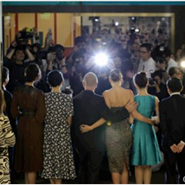- About
- Subscribe Now
- New York,
October 28, 2014

 Michael Kors Jet Set event in Shanghai
Michael Kors Jet Set event in Shanghai
Many brands have resorted to blitzing consumers with content in the misguided belief that abundance equals efficacy, according to a new report by L2 and Demandware.
Seventy-two percent of North American organizations created more or significantly more content in the last 12 months, oftentimes at the expense of content quality, visibility and utility. The positive correlation between strong content and commerce is clear and brands have to be shrewd about content deployment or otherwise watch their investments languish in a crowded space.
"As with everything in the digital age, the best user experience is an effortless one," said Elana Anderson, senior vice president of worldwide marketing at Demandware, Boston. "Engagement should require very few clicks.
"In the consumer consideration phase, context reigns supreme," she said. "Product content—video, looks, tutorials—helps the consumer make the mental leap from browse to buy."
L2’s Intelligence Report: Content & Commerce, in partnership with Demandware, benchmarks the current state of content investments and commerce integration across 80 global brands.
Pulley system
Branded content refers to content found on platforms where the brand controls all or most aspects of the consumer experience such as its Web site as opposed to platforms where control is shaky, such as Amazon.
Many brands recognize that independent content creation can wrest power away from traditional media players and marketplaces by providing consumers with the resources they want when shopping.
Barney's The Window app
The report presents a common example to highlight the discrepancy that should be exploited. On Amazon, a brand's product pages tend to be functional and simple: a few product images and reviews and a big shop button on a plain page. On a Web site, a brand can immerse consumers in a curated world of engaging content: videos, galleries, commentary, user-generated content and more.
In the process companies can create a more consistent brand image and also boost sales by featuring context on commerce pages to "lubricate" the purchase funnel.
Bally's redesigned Web site
The new mantra is becoming resonance and relevance over frequency and reach.
In a survey from the summer of 2015, 15 percent of marketers in North America planned to spend significantly more on B2C branded content over the next year and 45 percent planned to spend more. In Europe, these figures were higher.
Despite recognizing the opportunity, not all organizations are making good use of branded content. This disconnect sometimes stems from organizational morass, and sometimes from an absence of guiding content principles.
According to the Content Marketing Institute and Marketing Profs, 39 percent of B2C brands have a content strategy in place and 67 percent have a dedicated executive to watch over content efforts.
To make matters worse for brands without focus, "content shock" is taking place, a phase in which consumers are incapable of keeping up with content output.
L2 and Demandware identified three internal problems brands grapple with. First, decisions about content are often territorially split between ecommerce teams and marketing teams when these two parties should be working together.
Second, many brands are failing to integrate content throughout their Web sites, resulting in content that can be hard to find and content that fails to impact sales.
Finally, brands are inadequately localizing content across the globe. Exporting content from the United States into other markets can come across as tone-deaf and have little effect on sales.
The report then outlines some guiding principles for brands to follow that share a common theme: visibility. Blogs and microsites should be accessible from a Web site's homepage and articles should include links to products. Consumers should be able to slide down the purchasing funnel at any time.
Videos should be accessible on home pages and throughout the consumer journey to expound upon product features, provide context or engage.
User-generated content should be woven throughout the site experience, especially on product pages where potential buyers can relate to other consumers.
Versace user-generated content
Also, guided selling tools should accompany the consumer as she browses the site.
As this shift to greater independence continues, brands are reconfiguring how they assess content, with 51 percent of marketers expecting content to drive revenue, according to CMI.
The rest of the report explores these trends in greater detail and provides numerous best practices and case studies.
L2 Content and Commerce report
Spotty signals
Lancôme was among the high scoring brands in the report, creating strong content that consistently engages consumers.
To further boost loyalty the brand introduced a multichannel loyalty program that encourages social engagement and purchases for rewards points.
The brand will likely see otherwise one-time purchasers return to cash in on accrued benefits. For established consumers, Elite Rewards will spur greater displays of brand advocacy (see story).
Despite flashes of excellence, Lancôme struggles to maintain quality in every market. China, however, is a market that the beauty maker has cracked. Other brands are helping to lead the way in this critical market as well.
For instance, U.S. fashion label Michael Kors’ Jet Set collection campaign in Shanghai offers some tactics that luxury brands looking to gain recognition in China should consider leveraging, according to a new report by Resonance China.
The report breaks down each component of the campaign to provide a detailed framework of what occurred and how Michael Kors kept consumers engaged. As brands look to develop brand loyalty in China, campaigns of similar depth and nuance will have to be deployed (see story).
"Ecommerce is sitting at the nexus of several retail paradigm shifts - global expansion, omnichannel, and brands as publishers," Ms. Anderson said.
"True economy of scale is achieved when content can be syndicated across every brand touchpoint, globally, and propel consumers through the funnel," she said. "That is content’s true promise of power."
Final Take
Joe McCarthy, staff writer on Luxury Daily, New York
Share your thoughts. Click here